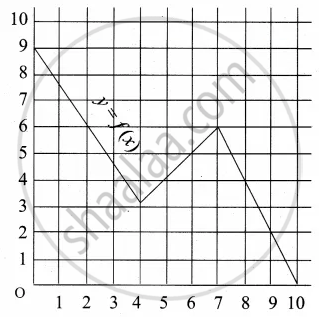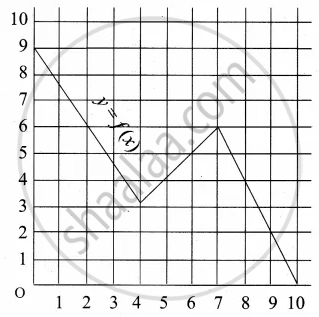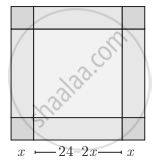Advertisements
Advertisements
प्रश्न
If f, g, h are real functions given by f(x) = x2, g(x) = tan x and h(x) = loge x, then write the value of (hogof)\[\left( \sqrt{\frac{\pi}{4}} \right)\] .
उत्तर
Given : f(x) = x2, g(x) = tan x and h(x) = loge x.
(hogof) \[\left( \sqrt{\frac{\pi}{4}} \right)\] = \[h\left( g\left( f\left( \sqrt{\frac{\pi}{4}} \right) \right) \right)\]
\[= h\left( g\left( \left( \sqrt{\frac{\pi}{4}} \right)^2 \right) \right)\]
\[ = h\left( g\left( \frac{\pi}{4} \right) \right)\]
\[ = h\left( \tan \left( \frac{\pi}{4} \right) \right)\]
\[ = h\left( 1 \right)\]
\[ = \log_e 1 = 0\]
APPEARS IN
संबंधित प्रश्न
If f(x) = x2, find `(f(1.1) - f(1))/((1.1 - 1))`
The function f is defined by \[f\left( x \right) = \begin{cases}x^2 , & 0 \leq x \leq 3 \\ 3x, & 3 \leq x \leq 10\end{cases}\]
The relation g is defined by \[g\left( x \right) = \begin{cases}x^2 , & 0 \leq x \leq 2 \\ 3x, & 2 \leq x \leq 10\end{cases}\]
Show that f is a function and g is not a function.
If \[f\left( x \right) = x^3 - \frac{1}{x^3}\] , show that
If f, g and h are real functions defined by
Let f(x) = x2 and g(x) = 2x+ 1 be two real functions. Find (f + g) (x), (f − g) (x), (fg) (x) and \[\left( \frac{f}{g} \right) \left( x \right)\] .
If f is a real function satisfying \[f\left( x + \frac{1}{x} \right) = x^2 + \frac{1}{x^2}\]
for all x ∈ R − {0}, then write the expression for f(x).
If \[f\left( x \right) = \log \left( \frac{1 + x}{1 - x} \right) \text{ and} g\left( x \right) = \frac{3x + x^3}{1 + 3 x^2}\] , then f(g(x)) is equal to
If 2f (x) − \[3f\left( \frac{1}{x} \right) = x^2\] (x ≠ 0), then f(2) is equal to
Check if the following relation is function:

If f(x) =` (2x−1)/ (5x−2) , x ≠ 2/5` Verify whether (fof) (x) = x
Check if the relation given by the equation represents y as function of x:
2x + 3y = 12
If f(m) = m2 − 3m + 1, find f(−3)
If f(m) = m2 − 3m + 1, find f(x + 1)
Find x, if f(x) = g(x) where f(x) = x4 + 2x2, g(x) = 11x2
If f(x) = `("a" - x)/("b" - x)`, f(2) is undefined, and f(3) = 5, find a and b
Let f be a subset of Z × Z defined by f = {(ab, a + b) : a, b ∈ Z}. Is f a function from Z to Z? Justify?
Show that if f : A → B and g : B → C are one-one, then g ° f is also one-one
Express the following exponential equation in logarithmic form
231 = 23
Express the following logarithmic equation in exponential form
log10 (0.001) = −3
Given that log 2 = a and log 3 = b, write `log sqrt(96)` in terms of a and b
If f(x) = 3x + 5, g(x) = 6x − 1, then find `("f"/"g") (x)` and its domain
Select the correct answer from given alternatives.
If log (5x – 9) – log (x + 3) = log 2 then x = ...............
The equation logx2 16 + log2x 64 = 3 has,
Answer the following:
A function f : R → R defined by f(x) = `(3x)/5 + 2`, x ∈ R. Show that f is one-one and onto. Hence find f–1
Answer the following:
Simplify `log_10 28/45 - log_10 35/324 + log_10 325/432 - log_10 13/15`
Answer the following:
If a2 + b2 = 7ab, show that, `log(("a" + "b")/3) = 1/2 log "a" + 1/2 log "b"`
A graph representing the function f(x) is given in it is clear that f(9) = 2

Describe the following Domain
A graph representing the function f(x) is given in it is clear that f(9) = 2

Describe the following Range
An open box is to be made from a square piece of material, 24 cm on a side, by cutting equal square from the corner and turning up the side as shown. Express the volume V of the box as a function of x

The range of the function f(x) = `(x - 3)/(5 - x)`, x ≠ 5 is ______.
The range of the function f(x) = `(x^2 - 3x + 2)/(x^3 - 4x^2 + 5x - 2)` is ______
The domain of the real valued function f(x) = `sqrt((x - 2)/(3 - x))` is ______.
Find the domain for which the functions f(x) = 2x2 – 1 and g(x) = 1 – 3x are equal.
Redefine the function which is given by f(x) = `|x - 1| + |1 + x|, -2 ≤ x ≤ 2`
Find the range of the following functions given by f(x) = 1 + 3 cos2x
(Hint: –1 ≤ cos 2x ≤ 1 ⇒ –3 ≤ 3 cos 2x ≤ 3 ⇒ –2 ≤ 1 + 3cos 2x ≤ 4)
The value of the function f(x) = `(x^2 - 3x + 2)/(x^2 + x - 6)` lies in the interval
The range of the function f(x) = x2 + 2x+ 2 is ______.
lf f : [0, ∞) `rightarrow` [0, ∞) and f(x) = `x/(1 + x)`, then f is ______.
